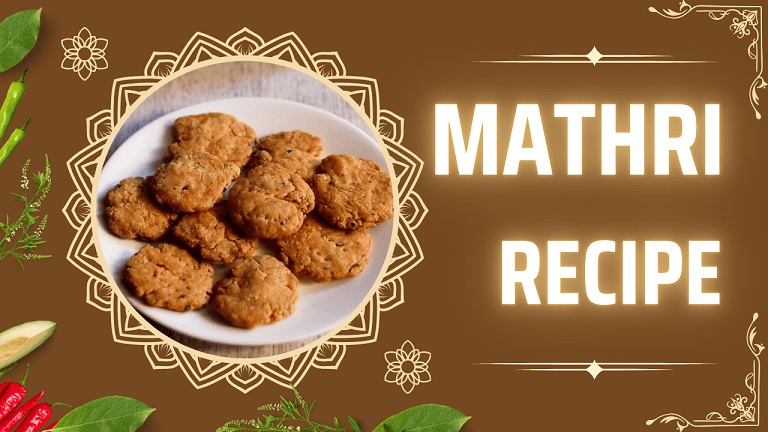Mathri Recipe
Mathri is a traditional North Indian snack, known for its crispy texture and flavorful taste. This savory delight is often enjoyed with a cup of tea, particularly during festivals or as part of family gatherings.
Mathri is typically made from wheat flour, flavored with spices like ajwain (carom seeds) and black pepper, and deep-fried to a golden crispness.
While it may seem like an indulgence, mathri can also be a nutritious addition to your diet if made with fresh, locally sourced ingredients and prepared thoughtfully.
By incorporating whole grains, healthy fats, and spices with medicinal properties, mathri can be transformed into a wholesome snack that retains its authentic flavors while boosting nutrition.
This recipe emphasizes using ingredients that are easily available in India, particularly fresh and locally sourced products that offer both flavor and nutritional benefits.
The mathri dough can be enriched with whole wheat flour, semolina (suji), and ghee, which together provide a good balance of carbohydrates, proteins, and fats, making the mathri filling and sustaining.
Additionally, you can customize the recipe to suit different dietary needs and preferences, such as gluten-free or vegan diets, without compromising on taste.
Ingredients
For a batch of 20-25 mathris, you will need the following ingredients:
Dry Ingredients
- Whole wheat flour: 1 ½ cups
- Semolina (Suji): ½ cup (optional, for extra crispiness)
- Besan (gram flour): 2 tablespoons (for additional flavor)
- Ajwain (carom seeds): 1 teaspoon (helps in digestion)
- Black pepper: 1 teaspoon, freshly ground (adds a mild spice and depth)
- Salt: 1 teaspoon, or to taste
- Cumin seeds: 1 teaspoon (adds earthy flavor)
- Red chili flakes: ½ teaspoon (optional, for a slight heat)
Wet Ingredients
- Ghee (clarified butter): ¼ cup (for richness and flaky texture)
- Water: ⅓ cup, as needed to form the dough
Oil for frying
- Peanut oil or mustard oil: 2 cups (for deep frying)
Instructions
Prepare the Dough
Sift the dry ingredients: In a large mixing bowl, combine the whole wheat flour, semolina, besan, ajwain, black pepper, salt, cumin seeds, and red chili flakes. Sift all dry ingredients together to ensure they are evenly distributed.
Add the ghee: Warm the ghee slightly if it’s solid. Add it to the flour mixture and rub it in using your fingertips. The texture should resemble coarse breadcrumbs. This step is important because the ghee helps make the mathri crispy and flaky.
Form the dough: Gradually add water, a little at a time, while kneading the flour mixture to form a stiff dough. The dough should not be too soft or sticky, as it needs to hold its shape during frying. Once the dough is formed, cover it with a damp cloth and let it rest for 15-20 minutes.
Shape the Mathri
Divide the dough: After resting, divide the dough into small, equal-sized portions. Each portion should be about the size of a walnut.
Flatten and shape: Roll each portion into a ball, then flatten it into a disc using your palms. The discs should be about 2-3 inches in diameter and around ¼ inch thick.
Prick with a fork: Use a fork to prick the surface of each mathri. This prevents them from puffing up during frying and ensures they stay crispy.
Fry the Mathri
Heat the oil: In a heavy-bottomed pan or kadhai, heat the oil over medium heat. To check if the oil is ready for frying, drop a small piece of dough into the oil – it should rise slowly to the surface without turning brown too quickly.
Fry in batches: Carefully add the shaped mathris to the hot oil, making sure not to overcrowd the pan. Fry them on medium-low heat, turning occasionally to ensure even cooking. The mathris should cook slowly to achieve an even golden-brown color and crispy texture.
Drain excess oil: Once the mathris are done, remove them from the oil using a slotted spoon and place them on paper towels to drain excess oil.
Cool and Store
Allow to cool completely: Let the fried mathris cool down completely before storing them. This helps retain their crispness.
Store in an airtight container: Once cooled, store the mathris in an airtight container. They can be stored for up to 2-3 weeks and remain fresh and crispy.
Variations and Substitutions
Mathri is a versatile snack, and you can easily modify the recipe based on dietary preferences or the availability of ingredients:
Vegan Mathri
Replace ghee with cold-pressed coconut oil or any neutral-flavored oil like sunflower oil. The mathris will still be crispy, though they may lack the characteristic richness imparted by ghee.
Gluten-Free Mathri
Substitute whole wheat flour with gluten-free flours like a combination of rice flour, besan, and buckwheat flour. Ensure the dough is slightly stiffer to avoid crumbling.
Baked Mathri
For a healthier, oil-free option, you can bake the mathris instead of frying them. Preheat your oven to 180°C (350°F), place the shaped mathris on a baking tray lined with parchment paper, and bake for 15-20 minutes or until they are golden and crispy. Turn them over halfway through baking to ensure even cooking.
Flavored Mathri
You can experiment with different flavors to give your mathris a unique twist. Add finely chopped herbs like coriander or mint for a fresh taste, or sprinkle some sesame seeds or flaxseeds on top before frying for added crunch and nutrition.
To make masala mathri, mix in powdered spices like dried mint, amchur (dry mango powder), and chaat masala for a tangy, spicy flavor.
Maximizing Flavor and Nutrition
Use whole wheat flour: Whole wheat provides more fiber and nutrients compared to refined flour, making the mathri a more wholesome snack.
Ghee for flavor and nutrition: While ghee adds flavor, it also has health benefits, such as aiding digestion and being rich in fat-soluble vitamins.
Ajwain for digestion: Ajwain or carom seeds are known for their digestive properties and add a slightly pungent, earthy flavor to the mathri.
Low-temperature frying: Frying the mathris at a medium-low temperature ensures they are cooked evenly and absorb less oil, making them lighter and less greasy.
Serving Suggestions
Mathri is typically enjoyed as a standalone snack, but it can be paired with various condiments and accompaniments for a more elaborate presentation:
With pickles: Serve mathri alongside homemade mango or lemon pickle for a tangy, spicy contrast.
With chutneys: Coriander-mint chutney or tamarind chutney are classic dips that complement the savory flavors of mathri.
As part of a snack platter: Create a festive snack platter by serving mathri with other traditional snacks like dhokla, sev, and papdi. Garnish with a sprinkle of chaat masala for added zing.
With masala chai: Mathri pairs perfectly with a hot cup of masala chai, making it an ideal evening snack.
Tips for Presentation
Rustic look: Present the mathris in a traditional brass or clay serving bowl for an authentic touch. The golden-brown mathris look especially appealing against the earthy tones of such containers.
Garnish with herbs: Sprinkle fresh coriander or a few sesame seeds on top of the mathris before serving to add visual appeal.
Serve with small dipping bowls: If serving with chutneys or pickles, use small, colorful bowls to enhance the presentation and create a vibrant contrast with the golden mathris.
Conclusion
Mathri is more than just a crispy snack; it carries with it the essence of traditional Indian flavors and offers a sense of nostalgia, especially when made with care and high-quality ingredients.
By using fresh, locally sourced ingredients, you can ensure that your mathri is not only delicious but also nutritious.
Whether fried or baked, plain or flavored, mathri is a versatile treat that can be enjoyed in many forms. Serve it at family gatherings, pack it for travel, or simply enjoy it with your evening tea for a wholesome, satisfying snack.
Thanks for visiting Veg Recipe

